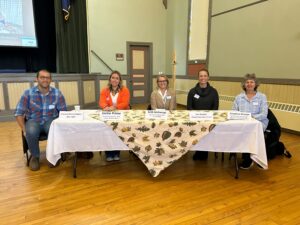This Fall the Rutland Council wanted to better understand the needs and resources around food insecurity in the state and in Rutland county. We were joined by Jill Hamilton MA, RDN, Public Health Nutritionist III, WIC Supervisor at the Vermont Department of Health.
Hunger in Vermont is a very real and present factor. According to Hunger Free Vermont 59,882 Vermonters live in food insecure households, meaning they do not have enough regular access to nutritious food. In Rutland County 14,600 residents visit a Foodbank network partner each year. Six percent of Foodbank clients in Rutland report having to choose between paying for food and paying for utilities.
There are 17,726 Vermont children that live in food insecure households. These children are at a greater risk of poor health, nutritional deficiencies and obesity. They have a higher risk of developmental delays, poor school performance, and are more likely to suffer from depression and increased aggressive or hyperactive behavior. Many child care providers report seeing this behavior and the challenges that it brings to their work.
How do families find out about resources?
There are programs available to families through WIC and other agencies. WIC will work with child care providers if given permission by families. Providers can receive credit for coloring pages and other activities to count towards WIC education. Health care providers and other social service providers can make referrals as well.
Vermont Farm to Table
Farm to Plate is Vermont’s food system plan being implemented statewide to increase economic development and jobs in the farm sector. Improved access to healthy local food for all Vermonters is their goal. Farm to Plate is coordinated by the Vermont Sustainable Jobs Fund.
Vermont Farmers Food Center
(VFFC) began as a grassroots, volunteer-led project and is spearheading the rebuilding of infrastructure necessary for agriculture to serve as a regional economic engine through the development of 2.93 acres of industrially zoned land with four existing buildings in the heart of Downtown Rutland. This location has a commercial kitchen that can be rented, in addition to other services intended to help food producers get their products to market
VFFC increases access and availability of locally produced food in the Rutland region by expanding markets and market access, aggregation, and distribution of locally produced and value added agricultural products. VFFC is the initiative of the Vermont Farmers Market Education Center, Inc., a 501(c) (3) nonprofit organization founded in Rutland, Vermont, in 2012.
Fresh Food as a prescription
When a doctor determines that a patient may be struggling with food insecurity, there are many ways to address the problem. Ideally, they can be referred to a one-on-one case manager or social worker that can meet with the patient separately and provide support in accessing all of the community resources available. This could be as simple as locating the nearest food shelf, identifying a transportation issue, or enrolling in government programs, such as SNAP or WIC.
A Health Care Share Prescription
Medical centers are also partnering with nonprofits pioneering the “Health Care Share” across the state, a program that provides families who suffer from diet-related illness with free weekly vegetables during Vermont’s growing season. Vermont Youth Conservation Corps has been the main coordinator of the program, and now six health communities are distributing a total of over 500 shares every year.
Armed with this information the Rutland BBF Council will share resources with families and other community partners to better inform the families of their options.
The council also was joined by Lauren Smith- Help Me Grow- Universal Screening Registry Manager-Vermont Dept. Of Health. Lauren walked the Council through the screening tool and discussed where and when the tool could be used. She also explained the significance of being a partner in gathering information. Often times families are more comfortable with, or have more time with a child care provider, than in the few minutes they might have with their doctor. In the familiar space of the child care setting families may share concerns. An ideal time to use the tool can be during conferences as a parent education tool. Using the screening tool with families can give them talking points with their health care provider, making the connection more meaningful and giving them a tool to advocate for their child in a medical setting.





